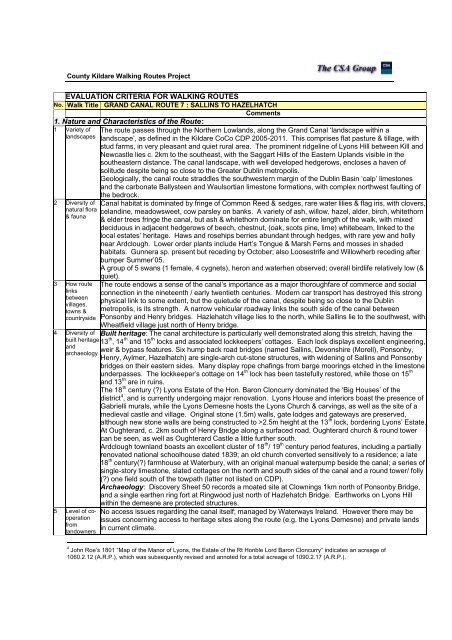County Kildare Walking Routes Project - Kildare.ie
County Kildare Walking Routes Project - Kildare.ie
County Kildare Walking Routes Project - Kildare.ie
You also want an ePaper? Increase the reach of your titles
YUMPU automatically turns print PDFs into web optimized ePapers that Google loves.
<strong>County</strong> <strong>Kildare</strong> <strong>Walking</strong> <strong>Routes</strong> <strong>Project</strong><br />
EVALUATION CRITERIA FOR WALKING ROUTES<br />
No. Walk Title GRAND CANAL ROUTE 7 : SALLINS TO HAZELHATCH<br />
Comments<br />
1. Nature and Characteristics of the Route:<br />
1 Var<strong>ie</strong>ty of<br />
landscapes<br />
2 Diversity of<br />
natural flora<br />
& fauna<br />
3 How route<br />
links<br />
between<br />
villages,<br />
towns &<br />
countryside<br />
The route passes through the Northern Lowlands, along the Grand Canal ‘landscape within a<br />
landscape’, as defined in the <strong>Kildare</strong> CoCo CDP 2005-2011. This comprises flat pasture & tillage, with<br />
stud farms, in very pleasant and qu<strong>ie</strong>t rural area. The prominent ridgeline of Lyons Hill between Kill and<br />
Newcastle l<strong>ie</strong>s c. 2km to the southeast, with the Saggart Hills of the Eastern Uplands visible in the<br />
southeastern distance. The canal landscape, with well developed hedgerows, encloses a haven of<br />
solitude despite being so close to the Greater Dublin metropolis.<br />
Geologically, the canal route straddles the southwestern margin of the Dublin Basin ‘calp’ limestones<br />
and the carbonate Ballysteen and Waulsortian limestone formations, with complex northwest faulting of<br />
the bedrock.<br />
Canal habitat is dominated by fringe of Common Reed & sedges, rare water lil<strong>ie</strong>s & flag iris, with clovers,<br />
celandine, meadowsweet, cow parsley on banks. A var<strong>ie</strong>ty of ash, willow, hazel, alder, birch, whitethorn<br />
& elder trees fringe the canal, but ash & whitethorn dominate for entire length of the walk, with mixed<br />
deciduous in adjacent hedgerows of beech, chestnut, (oak, scots pine, lime) whitebeam, linked to the<br />
local estates’ heritage. Haws and rosehips berr<strong>ie</strong>s abundant through hedges, with rare yew and holly<br />
near Ardclough. Lower order plants include Hart’s Tongue & Marsh Ferns and mosses in shaded<br />
habitats. Gunnera sp. present but receding by October; also Loosestrife and Willowherb receding after<br />
bumper Summer’05.<br />
A group of 5 swans (1 female, 4 cygnets), heron and waterhen observed; overall birdlife relatively low (&<br />
qu<strong>ie</strong>t).<br />
The route endows a sense of the canal’s importance as a major thoroughfare of commerce and social<br />
connection in the nineteenth / early twent<strong>ie</strong>th centur<strong>ie</strong>s. Modern car transport has destroyed this strong<br />
physical link to some extent, but the qu<strong>ie</strong>tude of the canal, despite being so close to the Dublin<br />
metropolis, is its strength. A narrow vehicular roadway links the south side of the canal between<br />
Ponsonby and Henry bridges. Hazlehatch village l<strong>ie</strong>s to the north, while Sallins l<strong>ie</strong> to the southwest, with<br />
4 Diversity of<br />
Wheatf<strong>ie</strong>ld village just north of Henry bridge.<br />
Built heritage: The canal architecture is particularly well demonstrated along this stretch, having the<br />
built heritage 13<br />
and<br />
archaeology<br />
th , 14 th and 15 th locks and associated lockkeepers’ cottages. Each lock displays excellent engineering,<br />
weir & bypass features. Six hump back road bridges (named Sallins, Devonshire (Morell), Ponsonby,<br />
Henry, Aylmer, Hazelhatch) are single-arch cut-stone structures, with widening of Sallins and Ponsonby<br />
bridges on their eastern sides. Many display rope chafings from barge moorings etched in the limestone<br />
underpasses. The lockkeeper’s cottage on 14 th lock has been tastefully restored, while those on 15 th<br />
and 13 th are in ruins.<br />
The 18 th century (?) Lyons Estate of the Hon. Baron Cloncurry dominated the ‘Big Houses’ of the<br />
district 4 , and is currently undergoing major renovation. Lyons House and interiors boast the presence of<br />
Gabr<strong>ie</strong>lli murals, while the Lyons Demesne hosts the Lyons Church & carvings, as well as the site of a<br />
med<strong>ie</strong>val castle and village. Original stone (1.5m) walls, gate lodges and gateways are preserved,<br />
although new stone walls are being constructed to >2.5m height at the 13 th lock, bordering Lyons’ Estate.<br />
At Oughterard, c. 2km south of Henry Bridge along a surfaced road, Oughterard church & round tower<br />
can be seen, as well as Oughterard Castle a little further south.<br />
Ardclough townland boasts an excellent cluster of 18 th / 19 th century period features, including a partially<br />
renovated national schoolhouse dated 1839; an old church converted sensitively to a residence; a late<br />
18 th 5<br />
century(?) farmhouse at Waterbury, with an original manual waterpump beside the canal; a ser<strong>ie</strong>s of<br />
single-story limestone, slated cottages on the north and south sides of the canal and a round tower/ folly<br />
(?) one f<strong>ie</strong>ld south of the towpath (latter not listed on CDP).<br />
Archaeology: Discovery Sheet 50 records a moated site at Clownings 1km north of Ponsonby Bridge,<br />
and a single earthen ring fort at Ringwood just north of Hazlehatch Bridge. Earthworks on Lyons Hill<br />
within the demesne are protected structures.<br />
Level of co- No access issues regarding the canal itself; managed by Waterways Ireland. However there may be<br />
operation issues concerning access to heritage sites along the route (e.g. the Lyons Demesne) and private lands<br />
from<br />
in current climate.<br />
landowners<br />
4 John Roe’s 1801 “Map of the Manor of Lyons, the Estate of the Rt Honble Lord Baron Cloncurry” indicates an acreage of<br />
1060.2.12 (A.R.P.), which was subsequently revised and annoted for a total acreage of 1090.2.17 (A.R.P.).
















